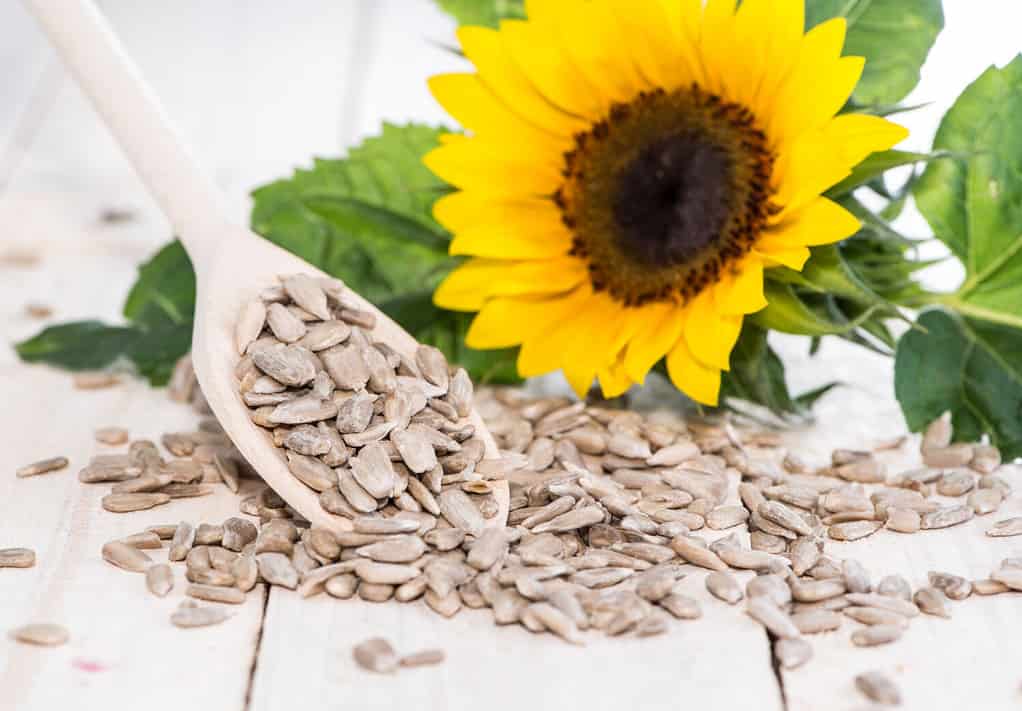Crows are a common type of bird that most people have seen. Unlike many other birds, crows do not migrate, so they are just as common in the winter. There are over 40 species of crows in the world, but the most well-known are the American crow, which is the most common species in the United States, and the carrion crow, which is the most common species in the United Kingdom. While different types of crows have different diets, most crows are omnivores, meaning they eat both plants and animals. They are opportunistic eaters that will eat a wide variety of foods, including fruit, seeds, eggs, and small animals. The availability of these foods changes seasonally, so crows have different diets in the winter than they do for the rest of the year. Here are three foods crows commonly eat during the winter.
1. Seeds, Nuts, and Grain

Crows will eat sunflower seeds directly from the flowers or from bird feeders.
©HandmadePictures/Shutterstock.com
Seeds are a significant part of a crow’s diet. This includes grains such as corn, wheat, and oats, and nuts such as pistachios, pecans, walnuts, almonds, peanuts, and hazelnuts. Crows forage for seeds that grow naturally on wild trees and other plants. In the winter, they also find seeds on the ground in harvested crop fields and will eat seeds from bird feeders if they can reach them.
Crows also store, or cache, seeds and other foods by burying them or hiding them in crevasses. In winter, when food is harder to find, these stored seeds can help. Crows are highly intelligent birds and can remember where they stored food to find it later.
2. Fruit

Chokecherries are also known as bird berries because many birds, including crows, eat them.
©iStock.com/rparys
Fruit is also a large part of a crow’s diet. Crows will eat just about any fruit they can find. Some of the American crow’s favorite fruits are chokecherries, poison ivy berries, grapes, Red Osier Dogwood fruits, Bittersweet Nightshade berries, watermelon, and apples. Much of this fruit comes from nature. Some wild fruits ripen in winter, and fruits that ripen in fall may still be available in winter as well. In areas developed by humans, crows will also forage in trash cans and compost piles for scraps of fruit discarded by humans. Many of the fruits humans eat are tasty to crows as well.
3. Carrion and Garbage

Dead animals, known as carrion, are a significant part of a crow’s diet.
©iStock.com/Nigel Harris
Throughout most of the year, crows hunt small animals in addition to plant foods. However, a lot of their usual prey, including insects, earthworms, reptiles, amphibians, smaller birds, and their eggs are not available in winter. While crows do occasionally hunt small mammals, they also supplement their diets with carrion, animals that are already dead. This can include roadkill and the leftovers from larger predators’ meals. Since crows do not have sharp beaks for tearing flesh, they prefer carrion that has already been torn apart.
In urban and suburban areas, crows also take advantage of food sources provided by humans. This includes trash and pet food. Crows are often drawn to urban areas due to the abundance of these food sources. Trash and human food are not the healthiest food for crows, but when other food is scarce, these resourceful birds manage to survive off of it.
Can humans feed crows in winter?
Since crows, like most other animals, struggle to find food in winter, many compassionate people want to help them by offering them food. It is generally okay to feed crows. However, you should limit the quantity of food offered and frequency of feeding, since giving any wild animals too much food can unintentionally harm them. If crows receive too much food from humans, they may become dependent on humans for food and lose their ability to find food in nature. Overfeeding crows can also cause their population to increase. This can damage the ecosystem as the crows hunt or compete with other animal species. It can also cause future food shortages for the crows if their population growth outpaces natural food sources.
If you do decide to feed crows, you can feed them nuts such as peanuts, almonds, and walnuts, fruit such as chopped apples and dried cranberries, or seeds such as sunflower seeds. Avoid feeding crows bread or any kind of processed food, since these foods have minimal nutritional value for crows and too much can make them sick. Caffeine, alcohol, chocolate, and avocadoes are toxic to all birds, so be sure to avoid these items as well. In addition, avoid feeding crows any food with added salt or sugar, including nuts and fruit. Although crows eat such foods when they find them on the ground or in trash cans, these foods are not the healthiest for them, and it is best not to add to the quantity of unhealthy food they eat.
The photo featured at the top of this post is © iStock.com/DanielLacy
Thank you for reading! Have some feedback for us? Contact the AZ Animals editorial team.






